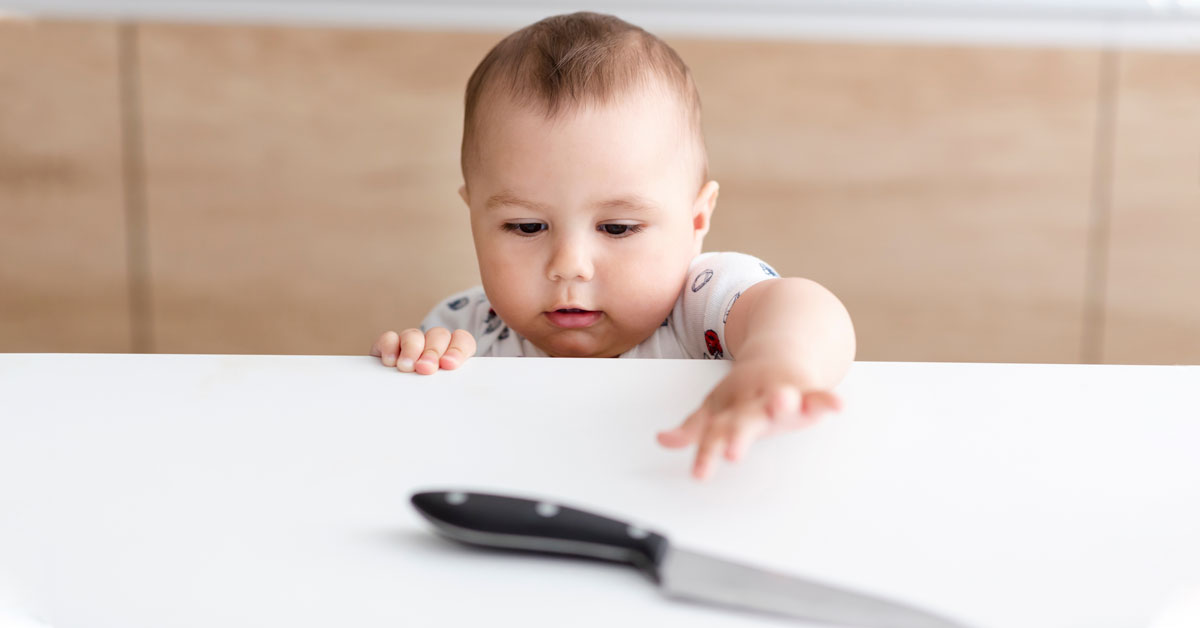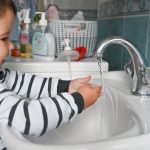
As your child grows, he gets curious about what goes on in the kitchen. It’s an amazing room filled with all kinds of tools and equipment used to make food.
When addressing dangers in the kitchen, instead of shooing the child away, perhaps it’s time you begin teaching him or her the importance of the kitchen. After all, knowledge can prevent accidents and keep others safe.
Setting Ground Rules
Establishing ground rules is very important to help keep the child safe in the kitchen. This list of dos and don’ts needs to cover everything from washing before preparing food to safely storing and utilizing sharp utensils such as knives and forks. There are many things that need to be addressed in the kitchen, and you may find it easier to make a list of what to cover before talking to your child.
Read Next | Getting Toddlers to Sleep and Developing Health Sleep Patterns
Teaching Children about Sharp Objects
The proper way to handle and hold sharp objects can keep everyone safe. Explain to your child that cutting away from the body prevents accidents. It may also be a good idea to use ceramic knives instead of stainless steel as this type poses less of a threat.
Teaching Children about Heavy Objects
There are many objects in the kitchen that can be heavy to move. Teaching your child how to lift heavy objects and handle larger appliances can reduce her risk of injury. Explain how team work is always the best course of action when something is too large to address by oneself.
Read Next | How to Maintain a Healthy Routine Through Tough Times
Electrical Appliances
One of the most important aspects to teach a child in the kitchen is the use of electrical appliances and tools. Everything from microwaves to blenders needs to be addressed. As easy as it is to leave a fork in a bowl in the microwave, little fingers in fast-moving blender beaters can prove dangerous. Toasters, ovens and even coffee makers can be too hot to touch with young hands.
Hot Surfaces and Liquids
Teach your child to respect hot surfaces and liquids. Stove tops, hot water, steam and various appliances can produce an amazing amount of heat. Your child needs to know that these aspects are dangerous and can cause everything from minor blisters to severe burns.
Dangers of Wet Floors
Many adults have broken limbs by slipping on wet floors. A child needs to understand how a wet surface such as this can pose a threat. Depending on the type of floor you have in the kitchen, even the slightest amounts of liquid can promote injury through slipping. Remind your child how all spills need to be cleaned up immediately to be safe.
Read Next | What is the Difference Between a Nanny and an Au Pair?
Ice and Cold Surfaces
All too often, someone puts a capped soda in the freezer to get it cold. However, pressurized objects such as this can create a mess as ice expands within any given container. This can not only make a mess, but it also has the potential to spoil food as well. Even touching the tongue to a frozen object can be painful and should be avoided.
Cabinet Doors
Keeping cabinet doors closed can prevent a long list of injuries, from banging a head to pinching fingers. Teach your child the importance of keeping the doors closed and show how these injuries can be prevented. It may also be prudent to teach how certain cabinets may be off limits, such as those with cleaning supplies.
Keeping the Kitchen Clean
The kitchen is not a playground, and your child needs to understand the importance of keeping toys out of this room. The cleaner the kitchen is, the safer it can become. Teach the child the basics of keeping the room picked up and organized to prevent injuries and messes.
Read Next | 6 Toddler Gift Ideas Made in the USA
Importance of Hygiene
Proper hygiene may be one of the more important lessons to teach your child. This keeps food safe from bacteria while reducing the spreading of germs to others. You should also go into detail about cleaning cutting boards and areas that were used for preparing meats, vegetables and other materials.
Keep an Eye on the Child
During this period of adjustment for the child in the kitchen, you should always hover nearby to ensure the environment is safe. Although he or she wants to assert independence, there are still many objects in the kitchen that can be dangerous. It’s always a good idea to remain close while the child is cooking or cleaning.
By getting your child involved in the kitchen, you can help him become more aware of the things that need to be done before and after a meal. This can provide a safer environment while making the child more conscious about the importance of cleanliness. Furthermore, this practice of getting the kids involved in meal preparation might help you to put a stop to their picky eating habits as well. Therefore, allow your kids to help you in the kitchen and share the experience of cooking.

Read Next | Watch out for These 8 Hidden Home Dangers in NYC Apartments
Patricia Dimick is a Denver based writer and a passionate coffee drinker. She loves to write about parenting topics and loves DIY jobs. When Patricia’s not writing or playing table tennis, she usually spends time with her precious daughter and a husband enjoying trips to nature. You can reach her @patricia_dimick.
Like what you read?JOIN the Mommybites community to get the latest on FREE online classes, parenting advice, events, childcare listings, casting calls & raffles, and our Parents With Nannies Facebook group. SIGN UP NOW!
The views and opinions expressed on this blog are purely the blog contributor’s. Any product claim, statistic, quote or other representation about a product or service should be verified with the manufacturer or provider. Writers may have conflicts of interest, and their opinions are their own.



